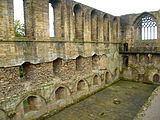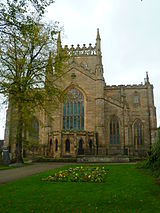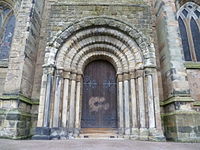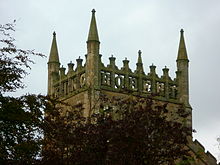- Dunfermline Abbey
-
Dunfermline Abbey 
Dunfermline Abbey from Pittencrieff ParkGeneral information Architectural style Scots-Norman Location Dunfermline, Fife, Scotland Coordinates 56°04′11″N 3°27′49″W / 56.0698°N 3.4636°WCoordinates: 56°04′11″N 3°27′49″W / 56.0698°N 3.4636°W Construction started 1128 Completed 1250 Design and construction Architect William Burn Dunfermline Abbey is as a Church of Scotland Parish Church located in Dunfermline, Fife, Scotland. In 2002 the congregation had 806 members. The minister (since 1991) is the Reverend Alastair Jessamine. The church occupies the site of the ancient chancel and transepts of a large medieval Benedictine abbey, which was sacked in 1560 during the Scottish Reformation and permitted to fall into disrepair. Part of the old abbey church continued in use at that time and some parts of the abbey infrastructure still remain to this day. Dunfermline Abbey is one of Scotland's most important cultural sites.
Contents
History
Early history
The abbey was founded in 1128 by King David I of Scotland, but the monastic establishment was based on an earlier foundation dating back to the reign of King Máel Coluim mac Donnchada (i.e. "Malcolm III" or "Malcolm Canmore", r. 1058-93) and his queen. It was administered by the Abbot of Dunfermline, its first being Geoffrey of Canterbury, former prior of Christ Church, Canterbury, the Kent religious house that probably supplied Dunfermline's first Benedictine monks. At the peak of its power it controlled four burghs, three courts of regality and a large portfolio of lands from Moray in the north down into Berwickshire.[1]
In the decades after its foundation the abbey gained power and wealth with the dedication of 26 altars gifted by individuals and guilds and was a lucrative centre of pilgrimage after Dunfermline became a centre for the well-promoted cult of St Margaret (Malcolm's wife and David's mother), from whom the monastery later claimed foundation and for which an earlier foundation charter was fabricated. The foundations of the earliest church (the Church of the Holy Trinity) are under the present superb Romanesque nave built in the 12th century.
During the winter of 1303 the court of Edward I of England was held in the abbey, and on his departure next year most of the buildings were burned.
Later history
During the Scottish Reformation, the abbey church was sacked in March 1560. Some parts of the abbey infrastructure still remain, principally the vast refectory and rooms over the gatehouse which was part of the former city wall. The nave was also spared and it was repaired in 1570 by Robert Drummond of Carnock. It served as the parish church till the 19th century, and now forms the vestibule of a new church. This edifice, in the Perpendicular style, opened for public worship in 1821, occupies the site of the ancient chancel and transepts, though differing in style and proportions from the original structure. Also of the monastery there still remains the south wall of the refectory, with a fine window. Next to the abbey is the ruin of Dunfermline Palace, also part of the original abbey complex and connected to it via the gatehouse.
Dunfermline Abbey, one of Scotland's most important cultural sites, has received more of Scotland’s royal dead than any other place in the kingdom, excepting Iona. One of the most notable non-royal names to be associated with the abbey is the northern renaissance poet, Robert Henryson. The tomb of Saint Margaret and Malcolm Canmore, within the ruined walls of the Lady chapel, was restored and enclosed by command of Queen Victoria.
Today
The current church building (on the site of the old Abbey's choir) remains in use as a Parish Church in the Church of Scotland, still with the name Dunfermline Abbey. In 2002 the congregation had 806 members. The minister (since 1991) is the Reverend Alastair Jessamine.
Architecture
The old building was a fine example of simple and massive Norman, as the nave testifies, and has a beautiful doorway in its west front. Another rich Norman doorway was exposed in the south wall in 1903, when masons were cutting a site for the memorial to the soldiers who had fallen in the Second Boer War. A new site was found for this monument in order that the ancient and beautiful entrance might be preserved. The venerable structure is maintained publicly, and private munificence has provided several stained-glass windows.
Famous Births, Marriages, & Burials
- Saint Margaret of Scotland was buried here in 1093; on 19 June 1250 following her Canonization her remains were disinterred and placed in a reliquary at the high altar. Her husband Malcolm's remains were also disinterred, and buried next to Margaret.
- Both Duncan II of Scotland 1094, and his wife Ethelreda, were buried here
- Edgar of Scotland was buried here in 1107
- Both Alexander I of Scotland 1124, and his queen Sybilla de Normandy 1122, were buried here
- David I of Scotland was buried here (1153) along with his queen Maud, Countess of Huntingdon (1130)
- Malcolm IV of Scotland was buried here in 1165
- Alexander III of Scotland (1286), was buried here, with his first wife Margaret of England (1275) and their sons David of Scotland (1281) and Alexander of Scotland (1284)
- Elizabeth de Burgh, wife of Robert I of Scotland, was buried here in 1327
- Robert the Bruce was buried, in 1329, in the choir, now the site of the present parish church. Bruce’s heart rests in Melrose, but his bones lie in Dunfermline Abbey, where (after the discovery of the skeleton in 1818) they were reinterred with fitting pomp below the pulpit of the New church. In 1891 the pulpit was moved back and a monumental brass inserted in the floor to indicate the royal vault.
- Matilda of Scotland, daughter of Robert I of Scotland, was buried here in 1353
- Anabella Drummond, wife of Robert III and mother of James I was buried here in 1401
- Robert Stewart, Duke of Albany was buried here in 1420
- Birthplace, in 1600, of Charles I, the last British monarch born in Scotland.
- William Schaw, Master of Work to the Crown of Scotland, was buried here in 1602: his tomb can still be seen.
- David Lindsay, 1st Lord Balcarres, son of John Lindsay of Balcarres, Lord Menmuir and father of Alexander Lindsay, 1st Earl of Balcarres, was married here in 1611
See also
- Abbot of Dunfermline
- Abbeys and priories in Scotland
- List of Church of Scotland parishes
- List of places in Fife
- Robert Henryson
References
- ^ Lamont-Brown Fife in History and Legend p.178-80.
External links
- Dunfermline Abbey (Church of Scotland congregation)
- Undiscovered Scotland article
- Catholic Encyclopedia article
Sources
 This article incorporates text from a publication now in the public domain: Chisholm, Hugh, ed (1911). Encyclopædia Britannica (11th ed.). Cambridge University Press.
This article incorporates text from a publication now in the public domain: Chisholm, Hugh, ed (1911). Encyclopædia Britannica (11th ed.). Cambridge University Press.
Categories:- Listed monasteries in Scotland
- Listed churches in Scotland
- Benedictine monasteries in Scotland
- Christian monasteries established in the 12th century
- Religious organizations established in the 1120s
- 1128 establishments
- Romanesque architecture in Scotland
- 1120s architecture
- Church of Scotland churches
- Listed buildings in Fife
- Scheduled Ancient Monuments in Scotland
- Historic Scotland properties
- Museums in Fife
- Dunfermline
- Religious museums in the United Kingdom
- Category A listed buildings in Scotland
Wikimedia Foundation. 2010.




